Discover Morel Mushroom Hunting
I love morel mushroom hunting. It is one of my absolute favorite spring pastimes, and has now become a seasonal ritual for my family. It took me a few years to really learn the art and science of morel hunting, and here I'd like to share what I've learned with you. My hope is that you learn some practical morel mushroom hunting tips that enable you to enjoy this prized delicacy and share in the joy of nature connection.
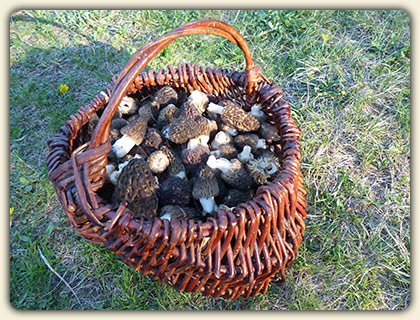
Yellers. Sponges. Dryland fish. Hickory chicken. Merkels. Molly moochers. Morchella.
All of these are names for the famous morel mushroom. The abundance of names is an indicator of just how much people love, and I mean LOVE, this wild edible fungus.
While it can take some time and patience to get started morel mushroom hunting, once you do watch out! Once you start you cannot stop. Hunting morels is highly engrossing, and has had me suddenly, seemingly randomly, slamming on the brakes to check out a possible spot. These days I often get in trouble with my wife for keeping our boys out long past their bedtime as we search for "just one more morel!"
I am blessed to live in Sandpoint, Idaho, which is a hot spot for morels. North Idaho is known by mushroom aficionados across the country as one of the best spots for morel mushroom hunting.
Indeed, morel mushrooms are choice, highly prized, gourmet cuisine, wild edible delicacies. The taste is par excellence. At my local health food store, they are currently going for $62.99 per pound!! Good thing I am practiced at morel mushroom hunting, otherwise I'd be broke!
History of Morels
The history of morels is interesting. While it is well known that they have been eaten for hundreds of years in many countries, I have not been able to find any record of traditional indigenous use of these amazing mushrooms. If anyone out there has ANY information about a traditional indigenous connection to morel mushrooms, please let me know.
Morel Identification
While it is true that there are 19 species of morels in North America, and 60 species worldwide, most of what you will actually harvest will be just two species, which I will cover here.
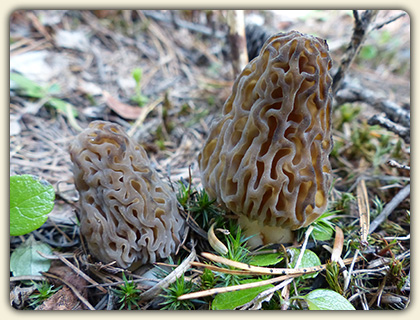
Black Morel - Morchella elata
Here in North Idaho where I live, this is the most prolific morel mushroom. This is true for most of the western states.
The black morel has a honeycombed head, with brown pits and ridges that are the same color brown, dark brown, or black, which is where it gets its name from. The stalk is whitish and somewhat grainy. It gets pits when older, and has no sack or cup at the base.
The head and stalk are one piece and hollow. This is very easy to see when you cut a black morel mushroom lengthwise in half. It is mostly pointed, but can be blunt. The spores (which are like the seeds of a mushroom) are found in the pits and are yellow to ochre in color. They escape in clouds when touched, or by wind, or even by light! Wow, that is sensitive.
Black morels are notoriously difficult to spot. This is why my boys and I love them so much, because of the grand adventure it is to find them. It is like an easter egg hunt every time we go out morel mushroom hunting, only the eggs are highly camouflaged! Indeed, the color, texture, shape, and pattern all blend in really well with the earth, especially mid spring when they are coming out.
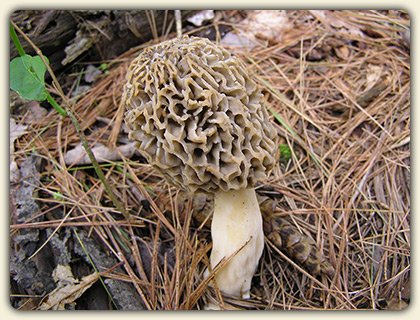
Yellow or Sponge Morel - Morchella esculenta
This is probably the more famous of the morels. As its name implies, it has a yellowish, sponge like head. It is very similar to the Black Morel (above). Besides the different color, the only other significant difference is that it tends to have more of a neck than the Black Morel. I also find that these Yellow or Sponge Morels are easier to find, as their coloration stands out more against the ground.
Warning!
This page is not intended to serve as the sole source of information for learning to harvest morels. There are deadly poisonous look-a-likes (see below), and you should not harvest any mushroom or plant that you have not successfully harvested at least a few times previously. If you have never harvested morels before, please take a class or go harvesting with an expert first to ensure your safety!
Poisonous Look-a-likes
When you are out hunting morels, there are two poisonous mushrooms that you should definitely be aware of, as they can be confused with the edible morel mushrooms.
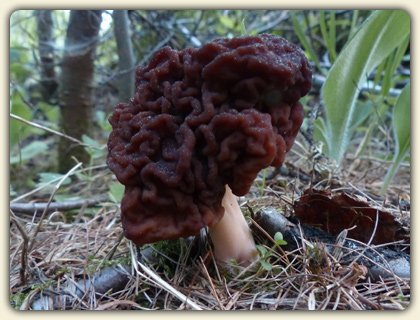
False Morel / Brain Mushroom - Gyromitra esculenta
This mushroom has a more or less round, brain like convoluted head, in various shades of brown or reddish brown. One key difference from a true morel is that it does NOT have the classic honeycombed head. It has a buff to pinkish stalk - swollen in center or base. It's habitat and the timing of its growth are both similar to that of true morels.
Most importantly, it is poisonous! - Deadly Poisonous. It contains a toxin that is in rocket fuel (ouch!), and has a delayed reaction from 1 to 24 hours. Don't mess with this one.
Hooded False Morel Gyromitra infula
This mushroom has a saddle or mitre shaped head. As with the previous poisonous mushroom, this one does not have the honeycombed head either. The head is brown, and starts smooth, getting more convoluted and wrinkled as it matures. The stalk whiteish, and again this one has a similar habitat and timing as true morels.
Once again, this mushroom is poisonous! - Anyone care for vomiting, diarrhea, and/or paralysis? Delayed reaction 1 to 24 hours. Leave this one alone folks!
Where to Harvest - Morel Habitat
OK, now that we know what (and what not) to look for, lets consider WHERE to look. This is a key, important point that many folks miss. Morel mushroom hunting is especially challenging and competitive, and most people tend to keep collection site secret. But I want to give you all a fighting chance, so here we go:
Morel mushrooms love burnt areas. The big pickers, who go out and harvest more morels in a day than is possible to carry out on their body, go to recently (1-3 years) burnt areas, especially here in the western states. This is where they come up in troves!
As well, be sure to check out disturbed and logged areas. Old orchards can also be great spots. In general, think moisture and warmth - which often equates to forests. They like sandy soils.
It is worth your while to learn your trees, as morels often times will grow under certain species. Here where I live, the Black Morels like to grow under evergreens such as the White or Grand Fir Abies grandis. Yellow Morels can also be found growing in gardens, wood chips, or landscaped areas.
Here are some other morel mushroom hunting tips. You'll find fewer morels when the spring is dry. Also, the mycelia (the underground network of mushroom "roots") tend to be short lived, so new patches must often be found each year. That said, I have had some patches produce year after year, so it is worth your while to check old spots.
When to Harvest
Morels love to grow in the springtime. Here where I live, it is late April or early May. But when it comes to timing, I encourage you to take a more nature based approach, as this will be more reliable. Look at the stage that other plants and trees are in rather than specific dates. For example, here the Quaking Aspens are starting to get their leaves and the wild strawberries are just beginning to flower.
Morel season can last two months or longer, moving up in elevation as the days get warmer. A great time to check is on a sunny day after it has rained, as this will really encourage morel mushroom growth (remember, they love it warm and wet). It is worthwhile to point out that Yellow Morels come out a bit earlier than Black Morels.
How to Harvest
First off, gather them in a woven basket or mesh bag to allow the spores to release. That will increase the chances of them coming back next year. DON'T use plastic bags, or buckets, as not only will these prevent the spores from releasing, but they will also make your morels get slimy quick!
Pinch or cut them at the base of the stem. DO NOT pull up and remove the root ball, or else you ruin any chance of the morel returning next year.
How to Process and Preserve
When you bring them home, take some time to immediately process them. Brush off any dirt with minimal pressure. If you are not going to use them immediately (personally I can never wait!), store them in a brown paper sack on the counter.
Generally speaking, morels should be eaten quickly or preserved quickly. Don't let them sit fresh for long as they can deteriorate quickly. Two or three days max on the counter in a brown paper bag.
There are different schools of thought on washing them. Some say not to wash them, as they will absorb water which dilutes the flavor, and can destroy the texture or bite. Others say to soak them overnight in salt water to kill any little worms or pests that may be in the mushrooms. Personally, I inspect them closely and only soak them in salt water if I can see significant worms & pests.
To preserve them, I recommend that you dry them. There are a few different approaches you can take. One is, but them in half lengthwise and use a standard dehydrator. I keep it going until they are thoroughly dried.
You can also thread them on a string and air dry them - think hot, dry, and a slight breeze. Another approach is to place them whole or cut in half lengthwise on a drying screen off the ground in direct sun. Keep them in full sun until dry.
How to Prepare
Morel mushrooms must be cooked, as cooking destroys a gastrointestinal irritant. These are choice, highly prized, gourmet, French cuisine mushrooms. The taste is par excellence. They taste best when fresh, harvested at just the right time, not too late. Morels are also high in Vitamin D. Remember, these tasty treats go for $62.99 at my local health food store, so take your time and prepare them well. Put on that French chef hat and go to town! You'll be glad you did.
I have created a whole page on morel recipes right here. Check this out to get some scrumptious morel recipes like Stuffed Morels, Sautéed Morels with Cream, Morels & Eggs, or Morels & Salmon! My mouth is watering…
Wrapping it Up
What a journey morel mushroom hunting is. It brings a really deep sense of satisfaction to harvest food from the wild, and share that with those I love. But there are also deeper teachings beyond all the fun and deliciousness that morel mushroom hunting offers.
The bigger teaching - Perception Determines Reality
Morel mushroom hunting has a lot to teach us about life. As I've said, morels can be very difficult to find, especially for beginners. Let's pause and take a look at this. It is not a matter of visual acuity, the eyes ability to see them, but it is a matter of pattern recognition - the brains capability to perceive and make meaning out of what the eyes see.
Beyond morel mushroom hunting with my boys, I am also a teacher, and I love to mentor others in their own journey of morel mushroom hunting. Many times have I watched as my students have gone out to find morels, and walked right through a huge patch, then finally "seen" (recognized) one, only to look around and notice that they had passed many dozens of morels getting to this point.
What is happening here? What is this telling us? What is this teaching us about life?
Our brain acts as a filter of sorts, discarding information it doesn't deem important. Before someone can recognize something, a "search image" has to be in place in the brain. And what we recognize has significant consequences. In this example, the person who recognizes morels gets to take them home, cook them up, and enjoy this delicacy.
What is the larger teaching?
What we experience is largely determined by what we are able to recognize and perceive. Think about that. For me, the burning question that comes up is, what experiences are we missing? How much more is there to life? What does it mean to truly hold an open mind?
For me, it encourages me to stay open. Open to other possible ways of viewing the world, especially when these new ways don't correspond with my own. This is a key tenet of being a lifelong learner, and staying truly health and happy in life.
Otherwise we could be living in a forest full of morels and never know it.
Additional Resources
If you are looking for more resources on morel mushroom hunting, be sure to check out these books:
- Mushrooms Demystified by David Aurora
- All that the Rain Promises by David Aurora
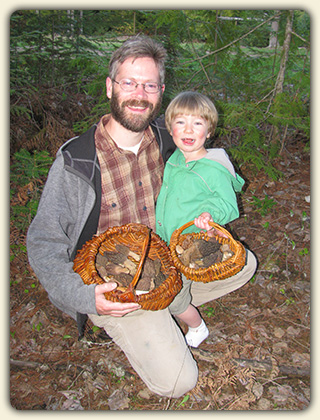
I hope you have found some useful, and perhaps enlightening, information here on this morel mushroom hunting page. Good luck on your morel mushroom hunting journey, and let me know how things go! May your life and your taste buds be full of rich nature connection!
Interested in being personally mentored in Edible Wild Plants, on a transformational journey of connection to nature, community, and self?
Check out the Twin Eagles Wilderness Immersion Program.
comments powered by Disqus
Return from Morel Mushroom Hunting to Edible Wild Plants
Return from Morel Mushroom Hunting to Wilderness Survival (homepage)
Track Us